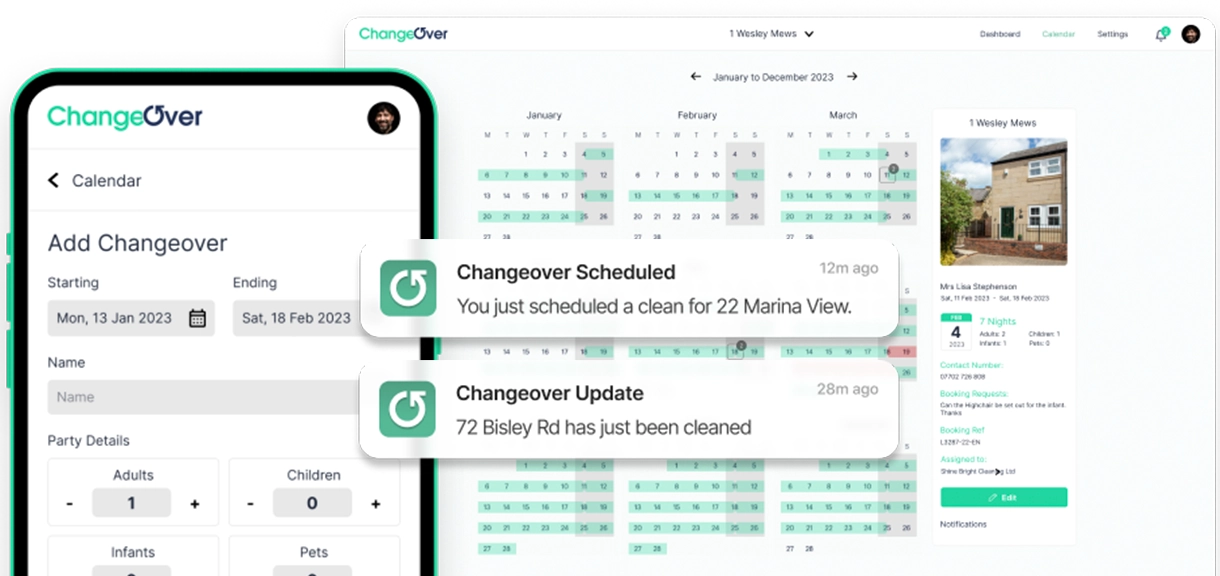Automate STR & Airbnb Cleaning
with our Easy-to-Use
Cleaning Service App
No more messy communications with your cleaner & worrying about missing a changeover!
Find out more
Welcome to our comprehensive guide on short-term rentals (STR) in real estate. If you’re new to the term or looking to invest, you’re in the right place! We’ll break down everything you need to know about STR real estate, compare it to long-term rentals (LTR), and offer tips on how to get started. So, let’s dive in and explore the exciting world of STR real estate.
When people ask, “What is an STR in Real Estate?” they are referring to properties that are rented out for short periods—typically ranging from a few days to a few weeks. Think vacation rentals, Airbnb listings, and other temporary accommodations. These properties are designed to cater to travelers and tourists looking for a home-like experience rather than a traditional hotel stay.
STR real estate is gaining popularity for several reasons. For one, it offers flexibility to both property owners and renters. Owners can enjoy their property when it’s not rented out, and renters get the comfort and amenities of a home away from home. Moreover, STR properties often generate higher rental income compared to long-term leases, making them an attractive investment.
Long-term rentals (LTR) involve leasing properties for extended periods, typically six months or more. This traditional approach provides steady income and stability for landlords. Tenants, on the other hand, benefit from having a secure place to live for a longer duration, usually at a lower monthly cost compared to short-term rentals.

Investing in STR real estate can be a lucrative venture if done right. Here are some steps to help you get started:
Understanding the market is crucial. Look for locations with high tourist traffic, popular attractions, and favorable regulations for short-term rentals. Analyze the competition and determine the demand for STR properties in the area. Knowing the answer to “What is an STR in Real Estate?” will help you identify potential hotspots for investment.
Not all properties make good STR investments. Look for homes that are in desirable locations, have appealing amenities, and can be easily maintained. Properties with unique features or those that offer a distinct experience tend to perform well.
Secure financing through traditional mortgages, private lenders, or even crowdfunding platforms. Ensure you have a solid financial plan and understand the costs involved, including property purchase, renovation, furnishings, and ongoing maintenance.
Once you’ve purchased the property, it’s time to get it ready for guests. Here are some key steps:
Make necessary renovations to ensure the property is safe, comfortable, and visually appealing. Invest in quality furnishings, modern appliances, and thoughtful decor. Remember, first impressions matter!
Check local regulations and obtain necessary permits or licenses for operating a short-term rental. Compliance with health, safety, and zoning laws is essential to avoid fines and legal issues.
Create a compelling listing on platforms like Airbnb, Vrbo, and Booking.com. High-quality photos, detailed descriptions, and positive reviews can attract more bookings. Highlight unique features and amenities to make your listing stand out.
Effective management is key to success in STR real estate. Here are some tips:
Respond promptly to inquiries and maintain clear, friendly communication with guests. Providing excellent customer service can lead to positive reviews and repeat bookings.
Ensure the property is clean and well-maintained. Consider hiring a professional cleaning service and performing regular maintenance checks to keep everything in top condition.
Set competitive pricing based on local market rates, seasonality, and demand. Adjust prices dynamically to maximize occupancy and revenue.
No more messy communications with your cleaner & worrying about missing a changeover!
Find out more
Certain locations are more favorable for STR investments due to their popularity among tourists and lenient regulations. Here are some top hotspots:
Cities like New York, London, and Tokyo attract a constant influx of tourists and business travelers, making them ideal for STR investments. Look for properties near major attractions, business districts, and public transport hubs.
Beach towns, mountain resorts, and historic cities often have a high demand for vacation rentals. Places like Miami, Aspen, and Venice offer great opportunities for STR investors.
Keep an eye on up-and-coming destinations that are gaining popularity. These areas might offer lower property prices and less competition, providing a good entry point for investors.
Several online platforms can help you find potential STR properties. Here are some popular ones:
These platforms not only allow you to list your property but also offer insights into local markets, occupancy rates, and pricing trends. Use them to research potential investment areas.
Websites like Zillow, Realtor.com, and Redfin list properties for sale, including those suitable for short-term rentals. Filter your search based on location, price, and property type to find the best options.
Platforms like Mashvisor and AirDNA provide data and analytics specifically for short-term rental properties. These tools can help you make informed investment decisions.

The STR real estate market continues to grow, driven by the rise of platforms like Airbnb and changing travel preferences. As more people seek unique, personalized travel experiences, the demand for short-term rentals is likely to increase. However, it’s important to stay informed about local regulations and market trends to navigate this dynamic industry successfully.
Investing in STR real estate can be highly rewarding but requires careful planning, management, and a willingness to adapt. If you’re ready to take on the challenge, the potential for high returns and the flexibility it offers can make it a worthwhile investment.
Whether you’re an experienced investor or just starting, understanding what an STR in real estate is and how to invest in it can open up new opportunities. With the right approach, you can turn a property into a profitable short-term rental and enjoy the benefits of this exciting market.
Changeover is a clever platform that shares your booking calendar with your cleaners & then fully automates the scheduling & management of changeovers. Sit back & relax as it tracks progress & sends notifications to ensure that everything is completed smoothly & on time.
Make changeovers simple & stress-free. In a few clicks, you can auto-schedule, share & track cleaning with ease.
Find out more
One of the most significant advancements in property management is the emergence of automated Apps. These innovative tools are designed...
Read article..Keep in touch & be one of the first to try
Changeover for free!
PS. As a thank you we've put together the ultimate STR & Airbnb cleaning checklist that we'll send you completely free!
Keep in touch & be one of the first to try
Changeover for free!
PS. As a thank you we've put together the ultimate STR & Airbnb cleaning checklist that we'll send you completely free!